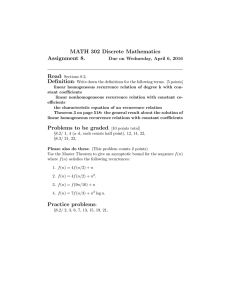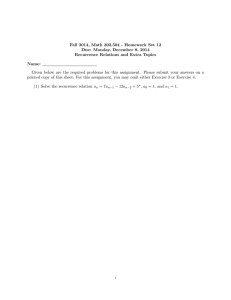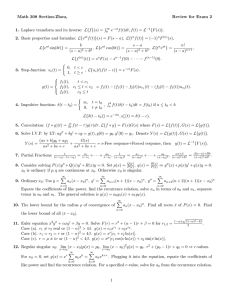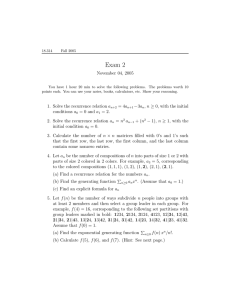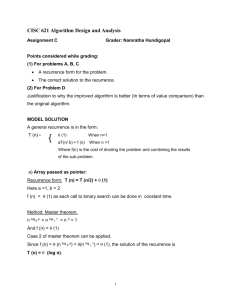HYERS-ULAM STABILITY OF THE LINEAR RECURRENCE WITH CONSTANT COEFFICIENTS
advertisement
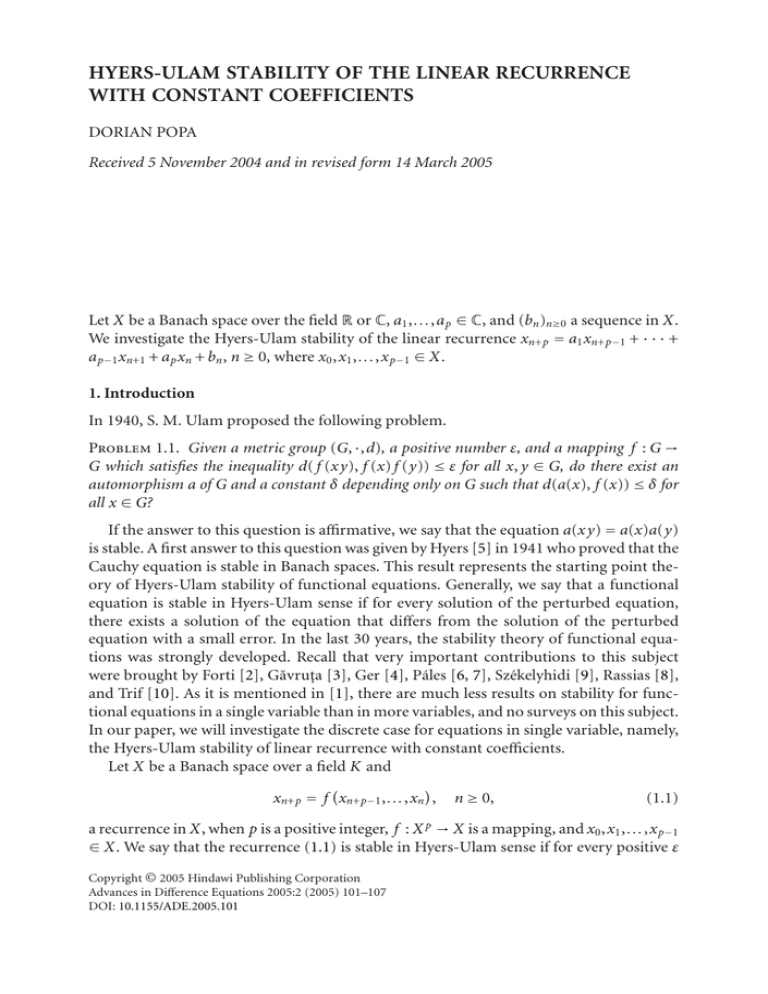
HYERS-ULAM STABILITY OF THE LINEAR RECURRENCE
WITH CONSTANT COEFFICIENTS
DORIAN POPA
Received 5 November 2004 and in revised form 14 March 2005
Let X be a Banach space over the field R or C, a1 ,...,a p ∈ C, and (bn )n≥0 a sequence in X.
We investigate the Hyers-Ulam stability of the linear recurrence xn+p = a1 xn+p−1 + · · · +
a p−1 xn+1 + a p xn + bn , n ≥ 0, where x0 ,x1 ,...,x p−1 ∈ X.
1. Introduction
In 1940, S. M. Ulam proposed the following problem.
Problem 1.1. Given a metric group (G, ·,d), a positive number ε, and a mapping f : G →
G which satisfies the inequality d( f (xy), f (x) f (y)) ≤ ε for all x, y ∈ G, do there exist an
automorphism a of G and a constant δ depending only on G such that d(a(x), f (x)) ≤ δ for
all x ∈ G?
If the answer to this question is affirmative, we say that the equation a(xy) = a(x)a(y)
is stable. A first answer to this question was given by Hyers [5] in 1941 who proved that the
Cauchy equation is stable in Banach spaces. This result represents the starting point theory of Hyers-Ulam stability of functional equations. Generally, we say that a functional
equation is stable in Hyers-Ulam sense if for every solution of the perturbed equation,
there exists a solution of the equation that differs from the solution of the perturbed
equation with a small error. In the last 30 years, the stability theory of functional equations was strongly developed. Recall that very important contributions to this subject
were brought by Forti [2], Găvruţa [3], Ger [4], Páles [6, 7], Székelyhidi [9], Rassias [8],
and Trif [10]. As it is mentioned in [1], there are much less results on stability for functional equations in a single variable than in more variables, and no surveys on this subject.
In our paper, we will investigate the discrete case for equations in single variable, namely,
the Hyers-Ulam stability of linear recurrence with constant coefficients.
Let X be a Banach space over a field K and
xn+p = f xn+p−1 ,...,xn ,
n ≥ 0,
(1.1)
a recurrence in X, when p is a positive integer, f : X p → X is a mapping, and x0 ,x1 ,...,x p−1
∈ X. We say that the recurrence (1.1) is stable in Hyers-Ulam sense if for every positive ε
Copyright © 2005 Hindawi Publishing Corporation
Advances in Difference Equations 2005:2 (2005) 101–107
DOI: 10.1155/ADE.2005.101
102
Hyers-Ulam stability of a linear recurrence
and every sequence (xn )n≥0 that satisfies the inequality
xn+p − f xn+p−1 ,...,xn < ε,
n ≥ 0,
(1.2)
there exist a sequence (yn )n≥0 given by the recurrence (1.1) and a positive δ depending
only on f such that
xn − yn < δ,
n ≥ 0.
(1.3)
In [7], the author investigates the Hyers-Ulam-Rassias stability of the first-order linear
recurrence in a Banach space. Using some ideas from [7] in this paper, one obtains a
result concerning the stability of the n-order linear recurrence with constant coefficients
in a Banach space, namely,
xn+p = a1 xn+p−1 + · · · + a p−1 xn+1 a + a p xn + bn ,
n ≥ 0,
(1.4)
where a1 ,a2 ,...,a p ∈ K, (bn )n≥0 is a given sequence in X, and x0 ,x1 ,...,x p−1 ∈ X. Many
new and interesting results concerning difference equations can be found in [1].
2. Main results
In what follows, we denote by K the field C of complex numbers or the field R of real
numbers. Our stability result is based on the following lemma.
Lemma 2.1. Let X be a Banach space over K, ε a positive number, a ∈ K \ {−1,0,1}, and
(an )n≥0 a sequence in X. Suppose that (xn )n≥0 is a sequence in X with the following property:
xn+1 − axn − an ≤ ε,
n ≥ 0.
(2.1)
Then there exists a sequence (yn )n≥0 in X satisfying the relations
yn+1 = ayn + an , n ≥ 0,
xn − yn ≤ ε , n ≥ 0.
|a| − 1
(2.2)
(2.3)
Proof. Denote xn+1 − axn − an := bn , n ≥ 0. By induction, one obtains
x n = an x 0 +
n
−1
an−k−1 ak + bk ,
n ≥ 1.
(2.4)
k =0
(1) Suppose that |a| < 1. Define the sequence (yn )n≥0 by the relation (2.2) with y0 = x0 .
Then it follows by induction that
y n = an x 0 +
n
−1
k =0
an−k−1 bk ,
n ≥ 1.
(2.5)
Dorian Popa
103
By the relation (2.4) and (2.5), one gets
n −1
−1
n
n −k −1 x n − y n ≤ bk |a|n−k−1
≤
b
a
k
k =0
k =0
1 − |a|n
ε
≤ε
<
,
1 − |a| 1 − |a|
(2.6)
n ≥ 1.
(2) If |a| > 1, by using the comparison test, it follows that the series
absolutely convergent, since
∞
n
n=1 (bn−1 /a )
bn−1 ε
an ≤ |a|n , n ≥ 1,
∞
ε
ε
=
.
n
|
a
|
|
a
|
−1
n =1
is
(2.7)
Denoting
s :=
∞
bn−1
n =1
an
,
(2.8)
we define the sequence (yn )n≥0 by the relation (2.2) with y0 = x0 + s.
Then one obtains
n
−1
n
−1
bk n −k −1 n
x n − y n − an s +
−
b
a
a
|
s
+
=
|
k
k+1 a
k =0
k =0
∞
b k n
= | a|
ak+1 (2.9)
k =n
≤ε
∞
1
ε
=
,
n
|
a
|
|
a
|
−1
n =1
n ≥ 0.
The lemma is proved.
Remark 2.2. (1) If |a| > 1, then the sequence (yn )n≥0 from Lemma 2.1 is uniquely determined.
(2) If |a| < 1, then there exists an infinite number of sequences (yn )n≥0 in Lemma 2.1
that satisfy (2.2) and (2.3).
Proof. (1) Suppose that there exists another sequence (yn )n≥0 defined by (2.2), y0 = x0 + s,
that satisfies (2.3). Hence,
−1
n
−1
n n
bk n −k −1 n
x n − y n ,
a x 0 − y 0 +
b
a
a
|
x
−
y
+
=
|
k
0
0
ak+1 k =0
n ≥ 1.
(2.10)
k =0
Since
n
−1
bk = x0 + s − y0 = 0,
lim x0 − y 0 +
k+1
n→∞
a
k =0
(2.11)
104
Hyers-Ulam stability of a linear recurrence
it follows that
lim xn − yn = ∞.
(2.12)
n→∞
(2) If |a| < 1, one can choose y0 = x0 + u, u ≤ ε. Then
n
−1
n
n −k −1 x n − y n = − an u +
≤ε
b
a
|a|k
k
=ε
k =0
n+1
1 − |a|
1 − |a|
≤
k =0
ε
1 − |a|
,
(2.13)
n ≥ 1.
The stability result for the p-order linear recurrence with constant coefficients is contained in the next theorem.
Theorem 2.3. Let X be a Banach space over the field K, ε > 0, and a1 ,a2 ,...,a p ∈ K such
that the equation
r p − a 1 r p −1 − · · · − a p −1 r − a p = 0
(2.14)
admits the roots r1 ,r2 ,...,r p , |rk | = 1, 1 ≤ k ≤ p, and (bn )n≥0 is a sequence in X. Suppose
that (xn )n≥0 is a sequence in X with the property
xn+p − a1 xn+p−1 − · · · − a p−1 xn+1 − a p xn − bn ≤ ε,
n ≥ 0.
(2.15)
Then there exists a sequence (yn )n≥0 in X given by the recurrence
yn+p = a1 yn+p−1 + · · · + a p−1 yn+1 + a p yn + bn ,
n ≥ 0,
(2.16)
such that
ε
xn − yn ≤ r1 − 1 · · · r p − 1 ,
n ≥ 0.
(2.17)
Proof. We prove Theorem 2.3 by induction on p.
For p = 1, the conclusion of Theorem 2.3 is true in virtue of Lemma 2.1. Suppose now
that Theorem 2.3 holds for a fixed p ≥ 1. We have to prove the following assertion.
Assertion 2.4. Let ε be a positive number and a1 ,a2 ,...,a p+1 ∈ K such that the equation
r p+1 − a1 r p − · · · − a p r − a p+1 = 0
(2.18)
admits the roots r1 ,r2 ,...,r p+1 , |rk | = 1, 1 ≤ k ≤ p + 1, and (bn )n≥0 is a sequence in X. If
(xn )n≥0 is a sequence in X satisfying the relation
xn+p+1 − a1 xn+p − · · · − a p xn+1 − a p+1 xn − bn ≤ ε,
n ≥ 0,
(2.19)
then there exists a sequence (yn )n≥0 in X, given by the recurrence
yn+p+1 = a1 yn+p + · · · + a p yn+1 + a p+1 yn + bn ,
n ≥ 0,
(2.20)
Dorian Popa
105
such that
ε
xn − yn ≤ r1 − 1 · · · r p+1 − 1 ,
n ≥ 0.
(2.21)
The relation (2.19) can be written in the form
xn+p+1 − r1 + · · · + r p+1 xn+p − · · · + (−1) p+1 r1 · · · r p+1 xn − bn ≤ ε,
n ≥ 0. (2.22)
Denoting xn+1 − r p+1 xn = un , n ≥ 0, one gets by (2.22)
un+p − r1 + · · · + r p un+p−1 + · · · + (−1) p r1 r2 · · · r p un − bn ≤ ε,
n ≥ 0.
(2.23)
By using the induction hypothesis, it follows that there exists a sequence (zn )n≥0 in X,
satisfying the relations
zn+p = a1 zn+p−1 + · · · + a p zn + bn , n ≥ 0,
ε
un − zn ≤ r1 − 1 · · · r p − 1 , n ≥ 0.
(2.24)
(2.25)
Hence
ε
xn+1 − r p+1 xn − zn ≤ r1 − 1 · · · r p − 1 ,
n ≥ 0,
(2.26)
and taking account of Lemma 2.1, it follows from (2.26) that there exists a sequence
(yn )n≥0 in X, given by the recurrence
yn+1 = r p+1 yn + zn ,
n ≥ 0,
(2.27)
that satisfies the relation
ε
xn − yn ≤ r1 − 1 · · · r p+1 − 1 ,
n ≥ 0.
(2.28)
By (2.24) and (2.27), one gets
yn+p+1 = a1 yn+p + · · · + a p+1 yn + bn ,
The theorem is proved.
n ≥ 0.
(2.29)
Remark 2.5. If |rk | > 1, 1 ≤ k ≤ p, in Theorem 2.3, then the sequence (yn )n≥0 is uniquely
determined.
Proof. The proof follows from Remark 2.2.
Remark 2.6. If there exists an integer s, 1 ≤ s ≤ p, such that |rs | = 1, then the conclusion
of Theorem 2.3 is not generally true.
106
Hyers-Ulam stability of a linear recurrence
Proof. Let ε > 0, and consider the sequence (xn )n≥0 , given by the recurrence
xn+2 + xn+1 − 2xn = ε,
n ≥ 0, x0 ,x1 ∈ K.
(2.30)
n ≥ 0,
(2.31)
A particular solution of this recurrence is
ε
xn = n,
3
hence the general solution of the recurrence is
ε
xn = α + β(−2)n + n,
3
n ≥ 0, α,β ∈ K.
(2.32)
Let (yn )n≥0 be a sequence satisfying the recurrence
yn+2 + yn+1 − 2yn = 0,
n ≥ 0, y0 , y1 ∈ K.
(2.33)
Then yn = γ + δ(−2)n , n ≥ 0, γ,δ ∈ K, and
sup xn − yn = ∞.
(2.34)
n∈N
Example 2.7. Let X be a Banach space and ε a positive number. Suppose that (xn )n≥0 is a
sequence in X satisfying the inequality
xn+2 − xn+1 − xn ≤ ε,
n ≥ 0.
(2.35)
Then there exists a sequence ( fn )n≥0 in X given by the recurrence
fn+2 − fn+1 − fn = 0,
n ≥ 0,
(2.36)
such that
√
xn − fn ≤ (2 + 5)ε,
n ≥ 0.
(2.37)
√
√
Proof. The equation r 2 − r − 1 = 0 has the roots r1 = (1 + 5)/2, r2 = (1 − 5)/2. By the
Theorem 2.3, it follows that there exists a sequence ( fn )n≥0 in X such that
√
ε
xn − fn ≤ r1 − 1 r2 − 1 = (2 + 5)ε,
n ≥ 0.
(2.38)
References
[1]
[2]
[3]
R. P. Agarwal, Difference Equations and Inequalities. Theory, Methods, and Applications, Monographs and Textbooks in Pure and Applied Mathematics, vol. 228, Marcel Dekker, New
York, 2000.
G. L. Forti, Hyers-Ulam stability of functional equations in several variables, Aequationes Math.
50 (1995), no. 1-2, 143–190.
P. Găvruţa, A generalization of the Hyers-Ulam-Rassias stability of approximately additive mappings, J. Math. Anal. Appl. 184 (1994), no. 3, 431–436.
Dorian Popa
[4]
[5]
[6]
[7]
[8]
[9]
[10]
107
R. Ger, A survey of recent results on stability of functional equations, Proc. of the 4th International Conference on Functional Equations and Inequalities (Cracow), Pedagogical University of Cracow, Poland, 1994, pp. 5–36.
D. H. Hyers, On the stability of the linear functional equation, Proc. Nat. Acad. Sci. USA 27
(1941), 222–224.
Z. Páles, Generalized stability of the Cauchy functional equation, Aequationes Math. 56 (1998),
no. 3, 222–232.
, Hyers-Ulam stability of the Cauchy functional equation on square-symmetric groupoids,
Publ. Math. Debrecen 58 (2001), no. 4, 651–666.
Th. M. Rassias, On the stability of the linear mapping in Banach spaces, Proc. Amer. Math. Soc.
72 (1978), no. 2, 297–300.
L. Székelyhidi, Note on Hyers’s theorem, C. R. Math. Rep. Acad. Sci. Canada 8 (1986), no. 2,
127–129.
T. Trif, On the stability of a general gamma-type functional equation, Publ. Math. Debrecen 60
(2002), no. 1-2, 47–61.
Dorian Popa: Department of Mathematics, Faculty of Automation and Computer Science, Technical University of Cluj-Napoca, 25-38 Gh. Baritiu Street, 3400 Cluj-Napoca, Romania
E-mail address: popa.dorian@math.utcluj.ro

